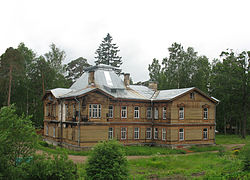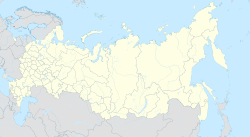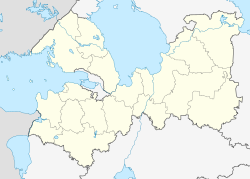world.wikisort.org - Russia
Lebyazhye (Russian: Лебя́жье; Finnish: Lepäsi) is an urban locality (an urban-type settlement) in Lomonosovsky District of Leningrad Oblast, Russia, located on the coast of the Gulf of Finland 25 kilometers (16 mi) west of Lomonosov and 30 kilometers (19 mi) east of Sosnovy Bor. Population: 4,729 (2010 Census);[3] 5,600 (2002 Census);[9] 5,340 (1989 Census).[10]
Lebyazhye
Лебяжье | |
|---|---|
Urban-type settlement[1] | |
 Saint Nicholas Church | |
Location of Lebyazhye  | |
 Lebyazhye Location of Lebyazhye  Lebyazhye Lebyazhye (Leningrad Oblast) | |
| Coordinates: 59°57′50″N 29°25′16″E | |
| Country | Russia |
| Federal subject | Leningrad Oblast |
| Administrative district | Lomonosovsky District[1] |
| Urban-type settlement status since | November 22, 1966[2] |
| Population | |
| • Total | 4,729 |
| • Estimate (2018)[4] | 4,322 (−8.6%) |
Municipal status | |
| • Municipal district | Lomonosovsky Municipal District[5] |
| • Urban settlement | Lebyazhenskoye Urban Settlement[5] |
| • Capital of | Lebyazhenskoye Urban Settlement[5] |
| Time zone | UTC+3 (MSK |
| Postal code(s)[7] | 188532 |
| Dialing code(s) | +7 81376[8] |
| OKTMO ID | 41630162051 |
| Website | www |
History
It was first mentioned in 1500 under the Swedish rule as Karkila. The area was conquered by Peter the Great in the early 18th century and was given by the Tsar to Boris Sheremetev. The Sheremetev family built a manor house here in the 18th century. After the Sheremetevs, the estate was known as Lebyazhye, apparently from Russian: лебедь — swan. In 1864, the railway was open, and in the 1860s, Lebyazhye started to specialize as a settlement for maritime pilots who brought the ships to Saint Petersburg. In the beginning of the 20th century, Lebyazhye was a popular summer holiday destination. Among notable people who owned houses there were Mikhail Saltykov-Shchedrin, an author, Valentin Bianki, a biologist, and Vitaly Bianki, his son and a future author.[11]
Krasnaya Gorka fort was constructed at the beginning of the 20th century on the coast near the settlement. The fort played a key part in the Siege of Leningrad as the center of the Oranienbaum Bridgehead during World War II.
In the beginning of the 20th century, Lebyazhye was a part of Petergofsky Uyezds of Saint Petersburg Governorate, with the center in Petergof. The governorate was renamed Petrograd in 1914 and Leningrad in 1924. On February 14, 1923 Petergofsky Uyezd was merged with Detskoselsky Uyezd to form Gatchinsky Uyezd, with the administrative center located in Gatchina.[12] On February 14, 1923 Gatchina was renamed Trotsk, and Gatchinsky Uyezd was renamed Trotsky Uyezd, after Leon Trotsky.[13]
On August 1, 1927, the uyezds were abolished and Oranienbaumsky District, with the administrative center in the town of Oranienbaum, was established. The governorates were also abolished, and the district was a part of Leningrad Okrug of Leningrad Oblast. On July 23, 1930, the okrugs were abolished as well, and the districts were directly subordinated to the oblast. Between August 1941 and January 1944, during World War II, Lebyazhye was a part of the Oranienbaum Bridgehead, which was protecting the city of Saint Petersburg. On February 23, 1948 the town of Oranienbaum was renamed Lomonosov to commemorate Mikhail Lomonosov, and the district was renamed Lomonosovsky. On November 22, 1966 Lebyazhye was granted urban-type settlement status.[2]
Restricted access
Lebyazhye along with the adjacent parts of Lomonosovsky District is included into the border security zone, intended to protect the borders of Russia from unwanted activity. In order to visit the zone, a permit issued by the local Federal Security Service department is required.[14]
Economy
In Lebyazhye, there is a large-scale poultry farm, as well as a number military installations.[15]
Transportation
Lebyazhye has a railway stations on the railway connecting the Baltiysky railway station of Saint Petersburg with Veymarn. The Lebyazhye railway station serves as a terminus for some suburban trains.
Lebyazhye is located on the A121 highway (Krasnoflotskoye Highway) which follows the southern shore of the Gulf of Finland and connects Saint Petersburg and Sosnovy Bor. There are bus connections to Saint Petersburg.
Culture and recreation


Lebyazhye contains thirteen objects classified as cultural and historical heritage of local significance. All of them commemorate events of the Russian Civil War and World War II.[16] These include a plinthed BMP-1 and Ilyushin Il-2 World War II aircraft.
Lebyazhye Railway Museum is located in the forest to the south of the Lebyazhye Railway Station. Amongst a number of interesting exhibits the museum is home to the very first Russian locomotive class LV namely OR18-01, Russian locomotive class P36-249 and the operable steam locomotive Su-206-56.
External links
References
Notes
- Государственный комитет Российской Федерации по статистике. Комитет Российской Федерации по стандартизации, метрологии и сертификации. №ОК 019-95 1 января 1997 г. «Общероссийский классификатор объектов административно-территориального деления. Код 41 230 562 002», в ред. изменения №278/2015 от 1 января 2016 г.. (State Statistics Committee of the Russian Federation. Committee of the Russian Federation on Standardization, Metrology, and Certification. #OK 019-95 January 1, 1997 Russian Classification of Objects of Administrative Division (OKATO). Code 41 230 562 002, as amended by the Amendment #278/2015 of January 1, 2016. ).
- Ораниенбаумский район (авг.1927 - фев. 1948 г .), Ломоносовский район (фев.1948 - фев. 196З, янв.1965) (in Russian). Система классификаторов исполнительных органов государственной власти Санкт-Петербурга. Archived from the original on November 3, 2013. Retrieved March 13, 2013.
- Russian Federal State Statistics Service (2011). Всероссийская перепись населения 2010 года. Том 1 [2010 All-Russian Population Census, vol. 1]. Всероссийская перепись населения 2010 года [2010 All-Russia Population Census] (in Russian). Federal State Statistics Service.
- "26. Численность постоянного населения Российской Федерации по муниципальным образованиям на 1 января 2018 года". Federal State Statistics Service. Retrieved 23 January 2019.
- Law #117-oz
- "Об исчислении времени". Официальный интернет-портал правовой информации (in Russian). 3 June 2011. Retrieved 19 January 2019.
- "List of postal codes" (in Russian). Russian Post. Archived from the original on December 12, 2006. Retrieved August 3, 2011.
- Ленинградская область (in Russian). Телефонные коды России. Retrieved 22 March 2013.
- Russian Federal State Statistics Service (21 May 2004). Численность населения России, субъектов Российской Федерации в составе федеральных округов, районов, городских поселений, сельских населённых пунктов – районных центров и сельских населённых пунктов с населением 3 тысячи и более человек [Population of Russia, Its Federal Districts, Federal Subjects, Districts, Urban Localities, Rural Localities—Administrative Centers, and Rural Localities with Population of Over 3,000] (XLS). Всероссийская перепись населения 2002 года [All-Russia Population Census of 2002] (in Russian).
- Всесоюзная перепись населения 1989 г. Численность наличного населения союзных и автономных республик, автономных областей и округов, краёв, областей, районов, городских поселений и сёл-райцентров [All Union Population Census of 1989: Present Population of Union and Autonomous Republics, Autonomous Oblasts and Okrugs, Krais, Oblasts, Districts, Urban Settlements, and Villages Serving as District Administrative Centers]. Всесоюзная перепись населения 1989 года [All-Union Population Census of 1989] (in Russian). Институт демографии Национального исследовательского университета: Высшая школа экономики [Institute of Demography at the National Research University: Higher School of Economics]. 1989 – via Demoscope Weekly.
- Карху, А. И. Приглашаем в Лебяжье (in Russian). Unofficial city of Oranienbaum. Retrieved 22 March 2013.
- Царскосельский уезд (1917 - нояб. 1918), Детскосельский уезд (ноябрь1918 - фев.1923) (in Russian). Система классификаторов исполнительных органов государственной власти Санкт-Петербурга. Archived from the original on May 19, 2013. Retrieved January 24, 2013.
- Гатчинский уезд (февр. 1923-авг. 1927) (in Russian). Система классификаторов исполнительных органов государственной власти Санкт-Петербурга. Archived from the original on March 4, 2016. Retrieved February 8, 2013.
- "Приказ ФСБ РФ от 2 июня 2006 года N 239 "О пределах пограничной зоны на территории Ленинградской области"; Приказ ФСБ РФ от 5 мая 2007 г. N 222 "О внесении изменений в Приказ ФСБ РФ ОТ 2 июня 2006 Г. N 239 "О пределах пограничной зоны на территории Ленинградской области""". Rossiyskaya Gazeta (in Russian). 2006.
- Труженики земли Ломоносовской (in Russian). Леноблинформ. December 4, 2009. Retrieved 21 March 2013.
- Памятники истории и культуры народов Российской Федерации (in Russian). Russian Ministry of Culture. Retrieved 2 June 2016.
Sources
- Законодательное собрание Ленинградской области. Областной закон №32-оз от 15 июня 2010 г. «Об административно-территориальном устройстве Ленинградской области и порядке его изменения», в ред. Областного закона №23-оз от 8 мая 2014 г. «Об объединении муниципальных образований "Приморское городское поселение" Выборгского района Ленинградской области и "Глебычевское сельское поселение" Выборгского района Ленинградской области и о внесении изменений в отдельные Областные законы». Вступил в силу со дня официального опубликования. Опубликован: "Вести", №112, 23 июня 2010 г. (Legislative Assembly of Leningrad Oblast. Oblast Law #32-oz of June 15, 2010 On the Administrative-Territorial Structure of Leningrad Oblast and on the Procedures for Its Change, as amended by the Oblast Law #23-oz of May 8, 2014 On Merging the Municipal Formations of "Primorskoye Urban Settlement" in Vyborgsky District of Leningrad Oblast and "Glebychevskoye Rural Settlement" in Vyborgsky District of Leningrad Oblast and on Amending Various Oblast Laws. Effective as of the day of the official publication.).
- Законодательное собрание Ленинградской области. Областной закон №117-оз от 24 декабря 2004 г. «Об установлении границ и наделении соответствующим статусом муниципального образования Ломоносовский муниципальный район и муниципальных образований в его составе», в ред. Областного закона №43-оз от 27 июня 2013 г. «О присоединении деревни Большая Загвоздка к городу Гатчина и о внесении изменений в некоторые Областные законы в сфере административно-территориального устройства Ленинградской области». Вступил в силу через 10 дней со дня официального опубликования. Опубликован: "Вестник Правительства Ленинградской области", №45, 30 декабря 2004 г. (Legislative Assembly of Leningrad Oblast. Oblast Law #117-oz of December 24, 2004 On Establishing the Borders of and Granting an Appropriate Status to the Municipal Formation of Lomonosovsky Municipal District and to the Municipal Formations Comprising It, as amended by the Oblast Law #43-oz of June 27, 2013 On Merging the Village of Bolshaya Zagvozdka into the Town of Gatchina and on Amending Various Oblast Laws on the Subject of the Administrative-Territorial Structure of Leningrad Oblast. Effective as of after 10 days from the day of the official publication.).
На других языках
- [en] Lebyazhye, Lomonosovsky District, Leningrad Oblast
[ru] Лебяжье (Ломоносовский район)
Лебя́жье (фин. Lepäsi) — посёлок городского типа в Ломоносовском районе Ленинградской области, центр Лебяженского городского поселения.Другой контент может иметь иную лицензию. Перед использованием материалов сайта WikiSort.org внимательно изучите правила лицензирования конкретных элементов наполнения сайта.
WikiSort.org - проект по пересортировке и дополнению контента Википедии